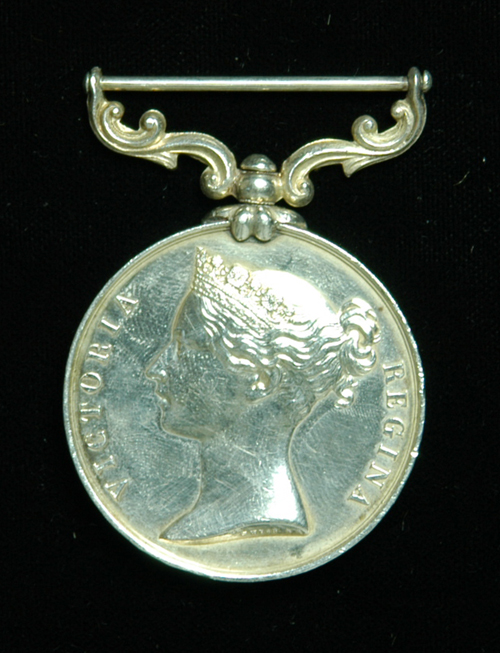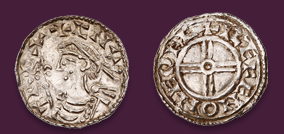
Auction: 7012 - Orders, Decorations, Medals & Militaria
Lot: 123
The Historically Interesting South Africa 1834-53 Medal to Lieutenant W. Fleming, 45th Foot, Who Commanded a Company at the Battle of Boom Plaats, August 1848, And Whose Extant Letters and Archives Are One of the Finest Contemporary Sources Of Military Information For the Campaign South Africa 1834-53 (Lieut. W. Fleming. 45th Regt.), minor edge bruising, therefore very fine, with modern portrait photographic image of recipient, and a bound version of typed manuscripts of the recipient´s letters during his military service, the original archive and an oil painting of Fleming resides in the National Army Museum Estimate £ 600-650 Lieutenant William Fleming (1829-1900), born Ennis, County Clare, Ireland; Ensign 45th Foot, 1846; arrived with his Regiment in Cape Colony, August 1846, during very turbulent times. Tension was apparent between the Voortrekkers and British forces, due the former´s quest to be recognised as independent in an independent state and the latter´s policy of provincial annexation. Fleming´s letters home and to other officers cover his entire period of service in South Africa, however of most interest are his letters for the period of 1846-48, which give a valuable insight into the Second Kaffir War which was raging at the time, especially his involvement at the Battle of Boom Plaats (29.08.1848), ´As you will have so many different accounts of the row we had yesterday, I just sit down to scribble a line or two which will give you all the true one....very circumstantial. We were five days crossing the Orange River and on the 6th day (27th inst.) we marched at daylight making about 18 miles a day on the road to Bloom Fontein. On the 3rd days march, that is yesterday, we had marched about 14 miles when we came to a place called Boom Platz there the Dutch opened fire on us from a most beautiful position. The Cape Corps immediately extended to the left. Dynely´s 3 guns opened in the centre and the infantry extended to the right of all. They are all mounted, about 30 of them, and much the same as the Tottie´s. Well sir, in this order Sir Harry called on us to advance and we drove them over two stony hills and regularly put them to flight on the next flat. It was the hardest work I ever had in my life mounting the rocks and when we got on the top and going down the next side we had it from the opposite hill pretty sharp. We ran as hard as we could across the flat between the hills and up the one the Boers had retired to (fixing bayonets) and when we got to the top they were going like blazes across the flat..... Blekinsopp led us like a man but the skirmishing was anything but regular....... the Rifles on the right of the line, we in the centre and 91st on the left but they all got mixed during the rush forward...... Baylis was about 5 yards from me and was shot quite dead thro´ the head....... I suppose about 50 Boers fell but there is no exact account........ We followed them up about 10 miles making a march of 24 miles altogether two hours of which was hard fighting. If I live to meet you again I can tell you some fine fellows in No.4.´ (Recipient´s letter to Captain R. Bates, dated 30.8.1848, refers). In a letter to his mother (3.9.1848), Fleming highlights his Company´s losses, ´In the Company I had the honour of Commanding I had 1 killed and 7 wounded.´ Prior to Boom Plaats, Fleming together with the re-enforcements sent to Sir Harry Smith´s Camp at Orange River, had marched 330 miles at roughly 15 miles a day to take part in the battle, ´The gallant conduct of the troops on this dashing occasion is equalled only by their exertions in crossing the great and un-fordable Orange River with very slender means and the cheerfulness with which they have marched nearly 400 miles without intermission.´ (General Orders, Camp, dated 30.8.1848). Fleming was promoted Lieutenant 1849, and was still in South Africa during the Third Kaffir War, however by this time he was stationed at Fort Napier, Pietermaritzburg. He returned to England and resigned his commission in 1854. He continued his education at St. Catherine´s College, Cambridge; L.L.B. 1859; Ordained Priest 1858, and spent the next 40 years pursuing ecclesiastical work, his last parish being Christ´s Church, Chislehurst, Kent. Fleming also wrote and had published Homeward Bound Rounding the Cape of Good Hope. Algoa Bay as a Harbour of Refuge Trade and Statistics of Port Elizabeth, the Sea-Port of Algoa Bay.
Sold for
£1,900




